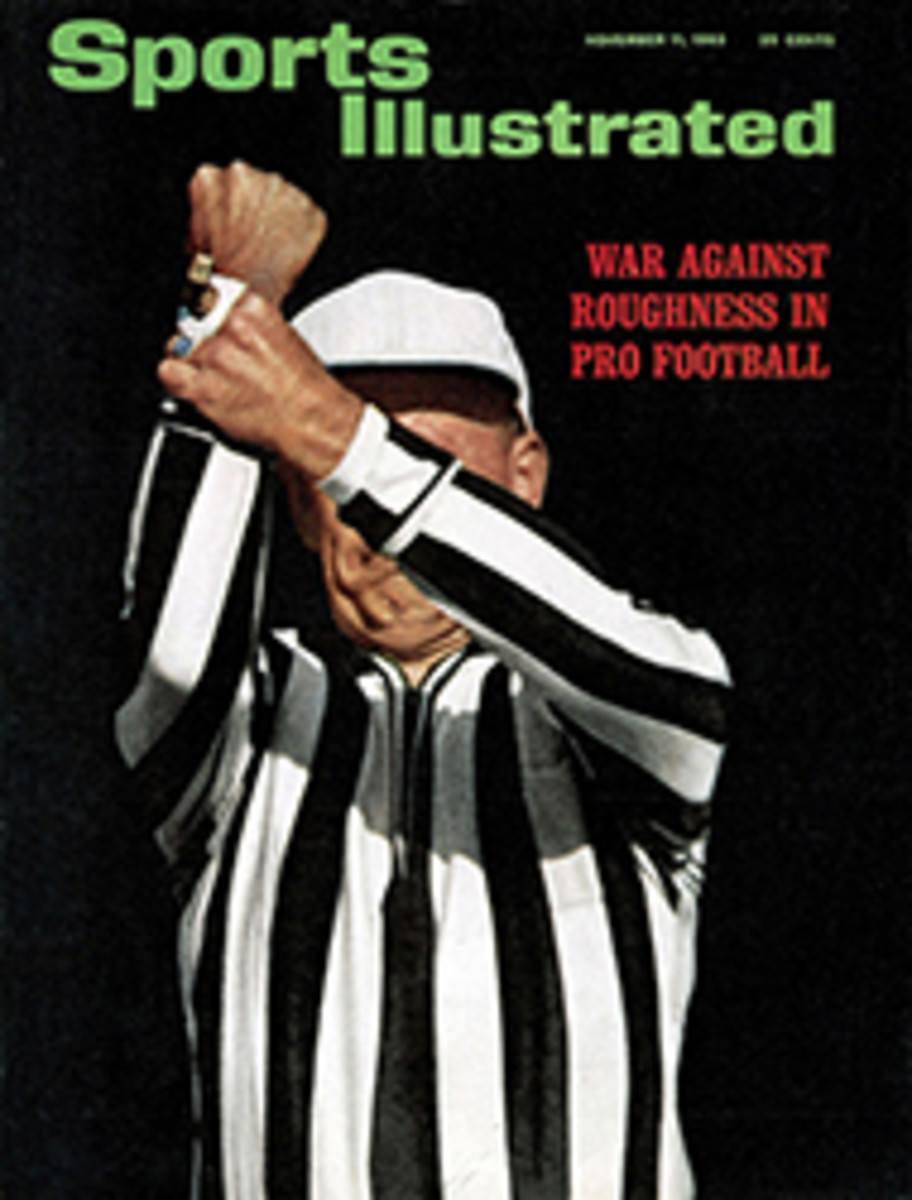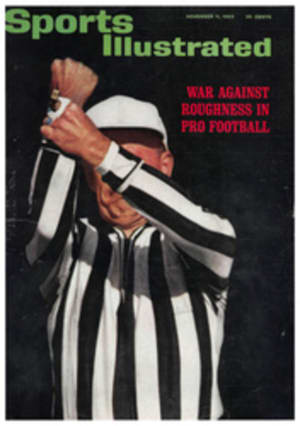
A big man in any league
Like the claims of a patent medicine pitchman, the spectacular Saturday afternoon statistics produced by football stars from the small colleges should be judged with healthy suspicion. Although strong tonic for the local fans, the flurries of touchdowns, the long runs and the passing averages that read like election returns are usually made against opposition as fierce as paper tigers.
But then there is the case of George Paul Bork, who last week had another dazzling aerial afternoon. Bork, a slender but remarkably nimble quarterback, led Northern Illinois to a taut 29-22 victory over archrival Western Illinois. In doing so, he completed 27 of 45 passes for 371 yards and four touchdowns. With one game remaining in his busy career, Bork has now thrown more passes (834), completed more (534) for more yardage (6,366) and more touchdowns (58) than any college player in history. This Saturday against Central Michigan he will have a chance to increase the single-season marks of 2,661 yards gained passing and 30 scoring passes already established by him this year, and to break the records for attempts (356) and completions (232) he set last year.
Bork, who has compiled the major part of these records in his last two years of competition, seems too fantastic to be genuine, yet some 20 scouts from professional teams have trooped onto the flat, sprawling Northern Illinois campus in De Kalb to see him.
"Scouting college players is guesswork at best," said hefty Lynn Waldorf, the former Kansas State, Northwestern and California coach who now bird-dogs for the San Francisco 49ers and was in De Kalb last Thursday to watch Bork. "But, regardless of the opposition, there are certain things you look for in a potential pro quarterback. First, he must be able to get the ball away quickly without a wind-up. Second, he should be able to throw off balance. Third, he should be able to dodge tacklers and still throw. Fourth, when his primary receiver is covered he should be able to quickly spot his secondary receiver. George has this equipment. That's why he's got such a fine record. And some of these small colleges play in a pretty tough league."
"Too many college quarterbacks who can throw the long bomb are actually getting away with something they wouldn't be able to get away with in our league," said Joe Thomas, head scout for the Minnesota Vikings, who showed up at the practice field the day after Waldorf had left it. "They take a big, long wind-up. You'll notice Bork never winds up. He takes a quick pump and lets it fly, short or long. He has amazingly quick wrists. The only problem with Bork is, is he strong enough? Can he take a beating and still bounce back?"
Bork is 6 feet 1 inch tall and weighs only 168 pounds, but his hands are large and his wrists long and strong and the pros think he can be fattened up. He grasps the football toward its tail end and so much out on the extremity of his fingers that the palm of his hand does not contact the leather of the ball at any point. When he throws, it is with the quick, wrist-snapping motion of a man firing darts. The ball is spun free with almost the same counterclockwise rotation of the wrist and fingers that a right-handed baseball pitcher would use in breaking off a fadeaway curve to a left-handed batter. This final, deft fillip, Bork's coach, Howard Fletcher, claims, keeps the nose of the football up, making it easy for receivers to catch.
Fletcher realized that he had something very special when Bork came to college, and he provided his team with an offense to take advantage of the passing—the shotgun. The ends are split wide, the two halfbacks and the fullback arrayed close behind the line of scrimmage, and Bork, as isolated as a tree on a bare prairie, takes his station eight to 10 yards back of the center. When Northern Illinois has the ball there is little doubt that the play is a pass. Bork usually has five receivers breaking downfield. This puts a great deal of pressure on Northern Illinois' five blocking linemen, but part of Bork's success stems from this quintet's mobile effectiveness.
Bork also has three receivers who can catch practically anything they touch. At one end is lanky Hugh Rohrschneider, a 6-foot-4, 205-pound farm boy from nearby Burlington, who has already drawn several long, searching looks from the Green Bay Packers. Last year Rohrschneider set an alltime college record of 76 receptions and this week against Central Michigan has an excellent chance to break the season record of 13 touchdown receptions and the career total of 176 passes caught, set by Washington State's Hugh Campbell. The other end is 6-foot Gary Stearns, who looks like a small-college version of the Philadelphia Eagles' Tommy McDonald. Bork's third favorite target is Jack Dean, a wispy, 5-foot-8 running back, who leads the team in rushing but seldom gets the opportunity to perform his specialty.
While searching downfield for his receivers, Bork is still able to sidestep the few tacklers that his linemen miss. He will backpedal swiftly, move up into a protective pocket or scamper frantically from one side of the field to the other. Bork calls the plays, but he is instructed by Coach Fletcher never to run the ball himself. Approximately 80% of the Huskies offense is passing—from anywhere and at any time.
Bork has made Fletcher's shotgun offense both exciting and consistently effective. So far this year it has brought Northern Illinois an undefeated season, unanimous ranking as the No. 1 small-college team in the country and fame—if not fortune—to the little town of De Kalb (population 11,000), located in the corn-growing plains of Illinois, 70 miles west of Chicago. The area is so flat that a small boy in a tall tree can see almost as far as he can ride a bicycle in a day's time. The picture at the university, however, is strictly up, up, up. In 1956 when Fletcher was called in as head football coach, the school was called Northern Illinois State College, had an undergraduate enrollment of 3,676 students (a majority of them coeds) and a football team that had won six games and lost 29 in four seasons. Today the school has achieved university status, an undergraduate enrollment of 8,000 that is increasing at the rate of 22% each year and a football team with a 34-10 record over the last five years. Football attendance at the school's rustic, 7,500-seat playing field has jumped from an average of 5,000 a game to almost 10,000, and the squeeze is not just in the seats.
"We are experiencing growing pains all right," says Athletic Director George Evans. "We're expanding so fast that we are getting too big for the rest of our conference [the Interstate Intercollegiate Athletic Conference]. We like them, but they might not like us pretty soon. We have to decide what our future policy is going to be."
Nothing has been said as yet, but the chances are future policy may involve major-college status and the Mid-American Conference, which includes perennially strong Bowling Green, Miami of Ohio and Ohio U. Naturally the sudden eminence of George Bork and the rest of the football team has not hurt the school's chances in this direction.
"Our national prominence has come at just the right time," said Fred Rolfe, a professor in NIU's chemistry department and chairman of the athletic board. He stood outside the tiny football field on the morning of NIU's last home game of the year, discussing plans for the new 22,500-seat stadium that should be ready for 1965. "It has had great impact on our program. We have a good one, 11 sports, and honestly administered. No under-the-table payments to football stars and only a modest grant-in-aid program. No one gets a free ride here. We have also tightened up our academic requirements for entrance. The fact that 12 seniors will be playing their last home game today may not be reassuring to Coach Fletcher, but I consider it a luxury. In the past our players had flunked out before their senior year."
The fact that Bork is one of these seniors is also a source of concern to the student body and the Huskie Boosters club downtown. It will be a long time before anyone in De Kalb has a chance to see the likes of George Bork again.
"I'll be sorry to see him go," said Howard Nelson, president of the De Kalb Trust & Savings Bank, one of the ardent members of the Booster club. "He has made such an interesting game of it...just like the pros do it."
"Whenever I used to tell people I was at NIU," recalls Terry Peters, sports editor of the undergraduate paper, The Northern Star, "They'd say, 'Oh yeah. De Kalb Teachers.' It was my pet peeve. Well, now everyone's talking about the football team and George Bork. They're not talking teachers anymore."
Last week the local fans had their last chance to watch their national hero. On a cold, bright afternoon, the band was set to spell out B-O-R-K at the half time and play You Gotta Be a Football Hero, and the crowd was set for fireworks. They got them from all directions. Three times Western Illinois, aroused by this chance to knock off No. 1, went ahead, and three times Bork's passing brought his team up to a tie and finally in front. At one point, on its own three-yard line, on second down with 11 to go, Northern made a daring first down on a jump pass by Bork over the middle. Then, early in the fourth quarter, as the Huskies trailed 22-16, Bork managed the kind of play that has made the pro scouts drool. Western had pulled in tight to protect against his short, sharp passes. Now, with the ball on the 34, second down and 11 for a first down, Bork called for a long pass. Taking the center snap 10 yards behind the line of scrimmage, Bork ran around one charging lineman, dodged another and then with what seemed to be the merest flick of his forearm, lofted a high, long pass down the left sideline. It was taken in full flight by Stearns, who galloped the remaining 30 yards for the score.
Bork is an amiable, if quiet, young man. He has blond, crew-cut hair, but his narrow face and long bony nose make him look like a pale-faced American Indian. He plays his hero's role with an Indian's stoicism.
"I never think about the records or anything like that when I'm playing," he says. "I pass a lot because that's what the coach thinks is best for us. And you can't fault the results." You cannot, any more than you can fault George Paul Bork. He is a small-college quarterback, but he is bound to go early in the pro drafts. He is as good as his records.
PHOTO

